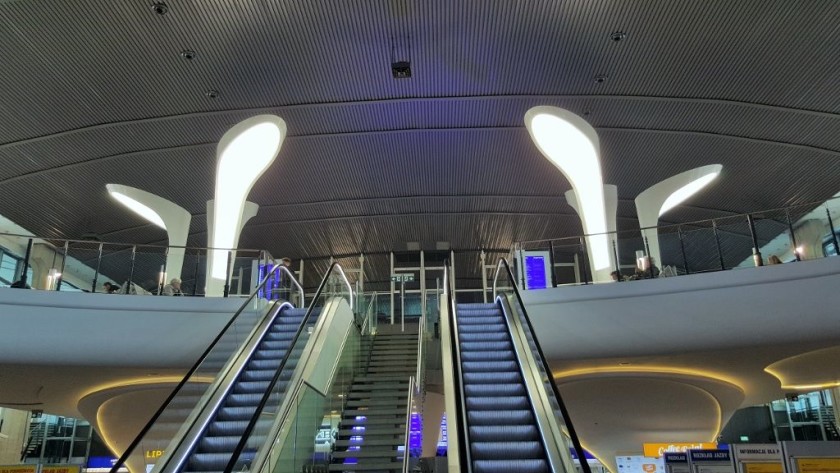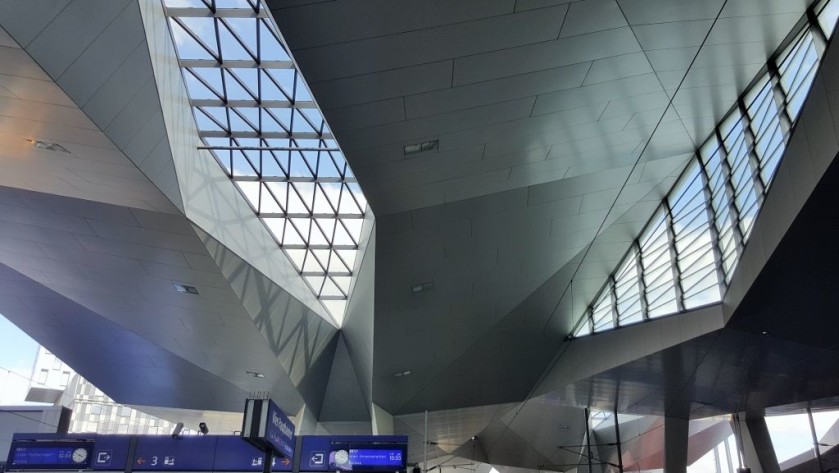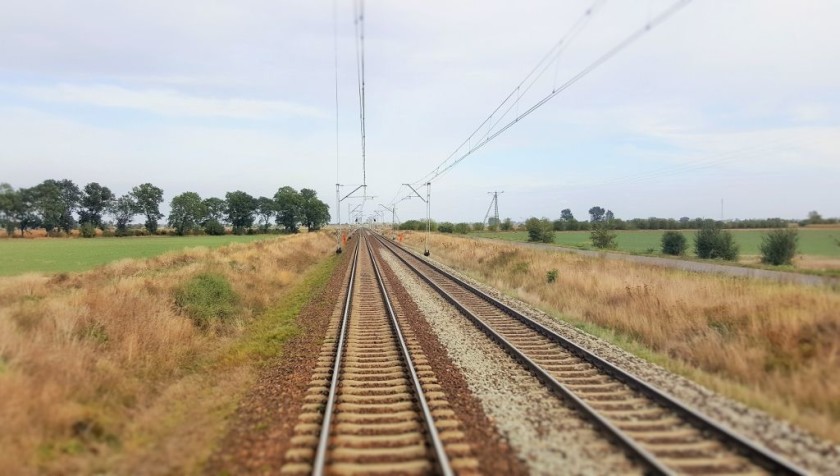Related Content
Content

Warszawa Centralna (Warszawa / Warsaw)
Our guide to the main railway station in Warsaw focuses on the less obvious aspects of arriving and departing from here by train.
Share
At a Glance
Services
Left Luggage
Travel Information Desk
Showers
Accessibility
Step Free
Onward Travel
Car Hire
Taxi Rank


Warszawa Centralna is a train station of contrasts.
On the outside it’s a text book example of stark brutalist Soviet era architecture, which we're rather partial to, though we appreciate it's not to everyone's taste.
However, the interior of Warszawa Centralna has been modernised, creating a pleasant, user-friendly environment in which to catch a train.
A particularly worthy achievement, as the platform/perons are below ground, because the trains arrive and depart within a rail tunnel which crosses the city.
Book Accommodation
1: Use the map above to see which hotel rooms and Vrbo rentals, with easy access to Warszawa Centralna station are available.
2: Or see what's available with Stay 22's accommodation partners; which include, Expedia, Hotels. com and Trivago over a wider area - by clicking here
Stay 22 will 'shuffle' the booking services so that you can be automatically directed to its partner that currently has the optimum availability at this location.
The other main stations in Warszawa
Warszawa has three stations used by long distance trains.
This station, Warszawa Centralna, lives up to its name with a location closest to the city centre - though it's still some distance from many of the most popular areas of Warsaw.
However, trains from the south and west call first at Warszawa Zachodnia station - before going on to call at Warszawa Centralna and then Warszawa Wschodnia station.
Mirroring this pattern, trains from the north and east call first at Warszawa Wschodnia station before going calling at Warszawa Centralna and then Warszawa Zachodnia.
So when arriving in the city by train, the first station in Warsaw that your train will call at WON'T be Warszawa Centralna and this may not be particularly obvious; so take care not to leave the train at the wrong station.
Departing By Train From Warszawa Centralna Station

When departing from Warszawa Centralna, making your way to the train can be (initially) bewildering, due to the numbering system for platforms/tracks used by PKP, the national express train operator in Poland.
Check our Poland guide for a full explanation, but at Warszawa Centralna the advice is to use the electronic departure indicators to initially discover which ‘peron’ (platform) your train will be leaving from.
The signage is excellent so making your way to the peron shouldn’t be too difficult.
When you're on the concourse don't be overly concerned about the specific 'track' that your train will be leaving from, you'll be able to work that out once you are on the ‘peron’ (platform).
To The Trains at Warsaw's Central Station:
Making your way to a train departure at Warszawa Centralns is a four stage process, which isn't as bewildering as it may initially seem.
(1) There are escalators and lifts down from the main concourse and you can use these to access an interim level; which also houses the left luggage office and numerous shops, cafés and food/drink outlets.
(2) From this interim level there are escalators and lifts down to each specific ‘peron’ (platform).
(3) The specific ‘tor’ (tracks) that the train will be departing from are on either side of the peron.
On each side of the peron (platform), there are electronic indictors for each specific tor/track giving details of the next train to depart from each track.
As shown on the image of the peron at Warszawa Centralna above.
The tracks/tors have their own numbers, which are separate to the peron numbers.
(4) The tracks/tors are also zoned and there are indicators on the 'peron' showing in which zone that the carriages/coaches of each train will be located.
You can use these indicators to work out where to wait on the track for easy boarding.
Do check these indicators, as some of the trains that depart from Warszaawa Centralna are much shorter than the length of the track, so only use one end of the platform (peron).
Keep the departure time of the train front of mind:
Warszawa Centralna is not a terminus station, in fact virtually all the trains which use it just call at the station on route to their final destinations.
However, most trains are scheduled to spend up to 10 mins in Warszawa Centralna between their arrival and departures.
As you make your way down to your train, you will see the peron (platform/track) that it will be departing from below you.
So it's likely that you will also see your train already waiting in the station, but unless you're cutting it very fine and only have a minute to spare; avoid panicking and hurtling down the steps/escalators.
It's likely that you won't have to rush, particularly if you have a reserved seat on the train, which only you will be entitled to occupy.
Changing Trains at Warszawa Centralna Station
There are electronic indicators on each platform/ peron that list each upcoming departure, so before exiting the peron, use them to discover which peron your subsequent train will be departing from.
If you’re lucky you may be able to remain on the same peron you have just arrived at.
If your next train is departing from a different platform/peron, you can use the interim concourse, that sits above the perons/platforms, to access your onward train.
There are cafés on this interim concourse in which you can wait for your next train.
Alternatively across the street from the station, there is a fairly new shopping mall which houses numerous cafés, so it can be worth heading there if you have more than 30mins to wait for a train.
Onward connections

Warszawa Centralna is the closest station to the city centre used by express trains, but its location in the city isn’t particularly convenient, unless you’re heading to the Palace of Culture And Science, as it happens to be just across the street.
Centralna station also isn't directly linked to the Warsaw Metro.
by Metro:
The closest Metro station to Warszawa Centralna is 'Centrum' station on Line M1; it’s a comparatively easy 5 – 8min walk away.
To reach Centrum from Centralna, leave the station by its exit on the street named 'Emilii Plater' and walk through the gardens on the opposite side of the road; the Palace of Culture And Science skyscraper will be to the left,
Or if the weather is poor, a slightly longer option is to use the underground passageway from Centralna to Śródmieście station and then take another passage from Śródmieście to Centrum station.
by tram to the Old Town and Royal Route:
For the old town - take tram lines 10, 17, 33 from tram stop ‘10’ on the street named ‘aleja .Jana.Patwa ii’ which is the main road to the west of the station;the opposite side of the station to the Palace of Culture And Science skyscraper.
The tram stop is somewhat hidden beneath the road flyover.
From here take a tram three stops to Kino Fermina and make a transfer there (go to the intersection of the two streets and turn left) to lines 13, 20, 23 eastbound and take any of these trams two stops to 'Stare Miasto'.
To access the old town from the Stare Miasto stop walk up the stairs, that lead to the street above the road tunnel.
The Stare Mistro tram stop is also at the northern end of Krakowskie Przedmieście (the Royal Route).
Walk up the stairs behind the tram stop and turn left at the top.
For the southern end of Krakowskie Przedmieście, take the Metro one stop north of Centrum to Metro Świętokrzyska station.
Then connect there for line M2 (direction Dworzec Wileński) and leave the train at Nowy Świat-Uniwersytet station.
by local train inc those to Chopin Airport:
The local/commuter trains in Warszawa (operated by KM and SKM) don’t call at Warszawa Centralna, instead they use a separate station nearby, named Warszawa Sródmieście.
SKM operates the rail link to Warsaw Chopin Airport (line S3 to Warszawa Lotnisko Chopina), so the trains to the airport don’t depart from/arrive at Centralna, you need to transfer to Śródmieście station.
From the interim concourse, above the peron/platforms at Warszawa Centralna, but below the main concourse, there is an underground passage way to Warszawa Śródmieście station - so taking this route particularly useful when the weather is poor.
The station is a 3min walk away.
Please support ShowMeTheJourney
This second version of ShowMeTheJourney is exciting and new, so we are genuinely thrilled that you are here and reading this, but we also need your help.
We’re striving not to let anything get in the way of providing the most useful service possible, hence a facility has been set up with DonorBox which can be used to support the running costs and make improvements.
Instead of advertising or paywalls, your financial support will make a positive difference to delivering an enhanced service, as there’s a lot of ideas which we want to make happen.
So if you have found the info provided here to be useful, please go here to say thank you.
Journeys
# Jump to a directionJourneys from Warszawa Centralna
Jump to directionsWarszawa / Warsaw to Berlin by train
Warszawa / Warsaw to Budapest by train
Warszawa / Warsaw to Gdańsk / Gdansk by train
Warszawa / Warsaw to Kraków / Krakow / Cracow by train
Warszawa / Warsaw to Lublin by train
Warszawa / Warsaw to Poznań / Poznan by train
Warszawa / Warsaw to Praha / Prague / Prag by train
Warszawa / Warsaw to Toruń / Torun by train
Warszawa / Warsaw to Wien / Vienna by train
Warszawa / Warsaw to Wroclaw by train
Warszawa / Warsaw to Łódź / Lodz by train
Journeys to Warszawa Centralna
Jump to directionsBerlin to Warszawa / Warsaw by train
Budapest to Warszawa / Warsaw by train
Köln / Cologne / Koeln to Warszawa / Warsaw by train
Praha / Prague / Prag to Warszawa / Warsaw by train
Wien / Vienna to Warszawa / Warsaw by train
This second version of ShowMeTheJourney is exciting and new, so we are genuinely thrilled that you are here and reading this, but we also need your help.
We’re striving not to let anything get in the way of providing the most useful service possible, hence a facility has been set up with DonorBox which can be used to support the running costs and make improvements.
Instead of advertising or paywalls, your financial support will make a positive difference to delivering an enhanced service, as there’s a lot of ideas which we want to make happen.
So if you have found the info provided here to be useful, please consider saying thank you.

This is one of more than 100 train travel guides available on ShowMeTheJourney, which will make it easier to take the train journeys you want or need to make. As always, all images were captured on trips taken by ShowMeTheJourney.













